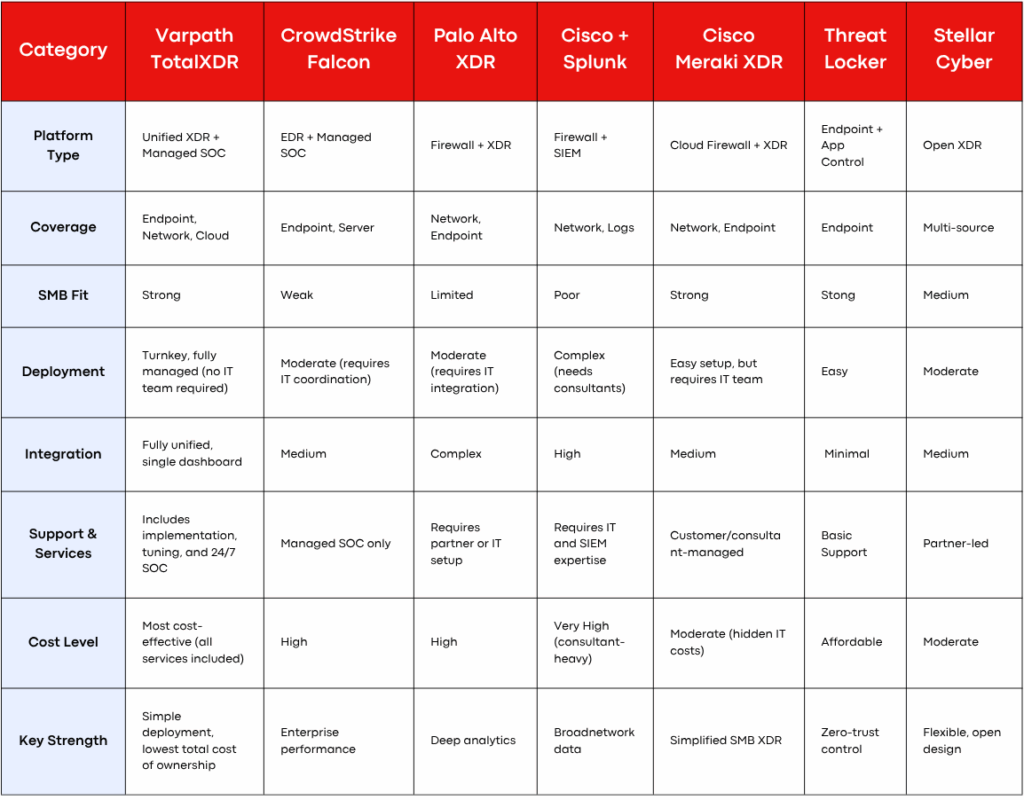What is Extended Detection and Response (XDR)?
In today’s cyber landscape, threats move fast across networks, devices, and users. Traditional security tools can’t keep up when each operates in isolation.
Varpath’s XDR (Extended Detection and Response), powered by WatchGuard’s ThreatSync, brings it all together unifying data from endpoints, firewalls, and identities into one intelligent defense system that automatically detects, correlates, and responds to threats.
Why WatchGuard XDR Matters?
WatchGuard XDR integrates network, endpoint, and identity protection into a single, coordinated solution. This means you gain faster detection, smarter response automation, and complete visibility all managed through one intuitive dashboard.
Whether you manage 10 endpoints or 10,000, XDR scales effortlessly to fit your business.

Key Benefits of Varpath XDR
- Gain a single-pane-of-glass view across your entire security environment. WatchGuard ThreatSync correlates data from endpoints, firewalls, and identities helping you see threats that standalone tools miss.
- Speed matters. XDR automates responses in real-time, isolating infected devices, blocking malicious IPs, and neutralizing attacks before they spread.
- Manage all detection, investigation, and response workflows from one dashboard with no need to juggle multiple consoles.
- Whether you’re a small office, an MSP managing multiple clients, or a large enterprise, XDR scales seamlessly to protect every endpoint and network.
- Integrate easily with your existing WatchGuard infrastructure for maximum protection and minimal overhead reducing total cost of ownership while improving operational efficiency.
- Stay ahead of emerging cyber risks with continuously updated threat intelligence. WatchGuard XDR leverages global threat feeds and AI-driven analytics to identify new attack patterns.
Simple to Use, Zero Configuration Required
Not all XDR solutions are easy to deploy. Many require complex setup, specialized skills, and additional hardware. WatchGuard simplifies everything with an intuitive, cloud-native platform powered by AI-driven automation. The entire solution runs seamlessly in WatchGuard Cloud, requiring no extra hardware or complex configuration just powerful protection that works right out of the box.

Reduce Overall Cybersecurity Expenses
XDR is a cornerstone of modern cybersecurity but it doesn’t have to come with enterprise-level costs. WatchGuard’s cloud-native XDR deployment eliminates the need for extra hardware and minimizes both deployment and operational expenses. At the heart of the solution, ThreatSync streamlines threat correlation and remediation across multiple security layers, helping your team cut costs and complexity without compromising protection.

How Is XDR Different?
XDR is a natural evolution from endpoint detection and response (EDR), which primarily focuses on endpoint security. XDR broadens the scope of security, integrating protection across a wider range of products, including endpoints, network, email, and more. From there, XDR combines prevention, detection, investigation, and response, providing visibility, analytics, correlated incident alerts, and automated responses to improve data security and combat threats.

XDR Solutions Comparison

Why Varpath Wins?
Varpath TotalXDR is a true turnkey solution no IT setup or outside consultants needed. This saves time and cost versus competitors that depend on IT teams or integrators.
If your company already has an IT team, Varpath hands them the keys to a fully set-up system. Your IT staff can focus on daily operations while Varpath experts fine-tune and optimize performance. This ensures your system runs smoothly from day one a major advantage over competitors.
FAQs
Frequently Asked Questions
What is XDR?
The eXtended Detection and Response concept, or XDR, is a SaaS tool that unifies the traditionally stove-piped deployment of cybersecurity tools so that defenders have a single correlated view of risks and threats and how to mitigate them.
How does XDR works?
XDR collects telemetry data and automatically correlates detections across multiple security domains including endpoint, identity, email, network, and Cloud. Using AI and machine-learning technologies, XDR then performs automatic analysis to integrate them into a centralized security system. As a result, security professionals get unified incident experience to take quicker remediation actions to stop a threat before it spreads within the organization.
What is XDR use for?
XDR breaks down the silos caused by disparate security tools, using a centralized approach that gathers and cross-detects threats from multiple security domains. XDR then automatically correlates these security alerts, turning them into larger incidents, allowing security teams greater visibility into attacks and providing incident prioritization, helping them to understand the risk level of the threat.

